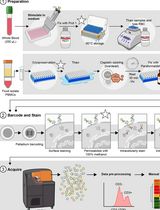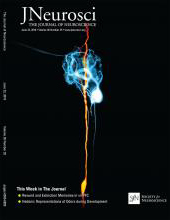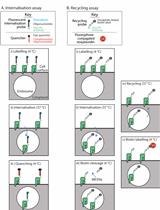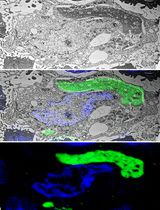- EN - English
- CN - 中文
Axonal Conduction Velocity Measurement
轴向传导速度测量
发布: 2017年03月05日第7卷第5期 DOI: 10.21769/BioProtoc.2152 浏览次数: 12010
评审: Soyun KimManqi WangKae-Jiun Chang

相关实验方案

用于比较人冷冻保存 PBMC 与全血中 JAK/STAT 信号通路的双磷酸化 CyTOF 流程
Ilyssa E. Ramos [...] James M. Cherry
2025年11月20日 887 阅读
Abstract
Action potential conduction velocity is the speed at which an action potential (AP) propagates along an axon. Measuring AP conduction velocity is instrumental in determining neuron health, function, and computational capability, as well as in determining short-term dynamics of neuronal communication and AP initiation (Ballo and Bucher, 2009; Bullock, 1951; Meeks and Mennerick, 2007; Rosenthal and Bezanilla, 2000; Städele and Stein, 2016; Swadlow and Waxman, 1976). Conduction velocity can be measured using extracellular recordings along the nerve through which the axon projects. Depending on the number of axons in the nerve, AP velocities of individual or many axons can be detected.
This protocol outlines how to measure AP conduction velocity of (A) stimulated APs and (B) spontaneously generated APs by using two spatially distant extracellular electrodes. Although an invertebrate nervous system is used here, the principles of this technique are universal and can be easily adjusted to other nervous system preparations (including vertebrates).
Background
Long-distance communication in the nervous system is mediated by APs that travel along axons. The ionic currents that flow across the axon membrane when an AP is generated (Hodgkin and Huxley, 1952) can be detected even outside of the neuron, using extracellular recording electrodes. AP conduction velocities in different neurons are quite variable and range from 200 meters per second (447 miles per hour) to less than 0.1 meters per second (0.2 miles per hour) (Kress et al., 2008; Kusano, 1966). In order to understand why there are differences in conduction velocity, the passive (membrane) properties of the axon need to be taken into account. Some axons propagate information more rapidly than others because of differences in properties that affect the time constant (e.g., resistance and capacitance) and the length constant (e.g., axon diameter, membrane permeability, and degree of myelination). Especially in unmyelinated axons, conduction velocity largely depends on the axon diameter, which in turn is also correlated with the amplitude of the extracellular AP (Stein and Pearson, 1971). Consequently, determining AP conduction velocity provides more than just information about signal movement and timing. It can also be used to characterize changes in intrinsic axon properties.
Materials and Reagents
Note: The materials and equipment listed refer to the equipment used in Städele and Stein (2016). To reduce costs, comparable materials, equipment and software may be used that serve the same functions. For the general public or a teaching classroom we suggest utilizing equipment from Backyard Brains (http://backyardbrains.com).
- Petri dish (100 x 15 mm, Fisher Scientific, catalog number: FB0875713 ) lined with silicon elastomer (e.g., Sylgard 184, Sigma-Aldrich, catalog number: 761036 ; or Elastosil RT 601, Wacker Chemie, catalog number: 60063613 )
- Minutien pins (Fine Science Tools, catalog number: 26002-10 )
- Modeling clay (craft store)
- Syringe, filled with petroleum jelly (100% pure, pharmacy)
- Recording/stimulation electrodes
Note: For details how to prepare the petroleum jelly filled syringe or recording/stimulating electrodes, see our companion protocol ‘Extracellular axon stimulation’ by Städele, C., DeMaegd, M. and Stein, W. - Dissected nervous system
Note: We are using adult Jonah crabs (Cancer borealis), purchased from The Fresh Lobster Company (Gloucester, MA). - Physiological saline (see Recipes)
The recipe for C. borealis saline can be found in Table 1 - Sodium chloride, NaCl (Sigma-Aldrich, catalog number: S9625 )
- Magnesium chloride hexahydrate, MgCl2·6H2O (Sigma-Aldrich, catalog number: M9272 )
- Calcium chloride dihydrate, CaCl2·2H2O (Sigma-Aldrich, catalog number: C7902 )
- Potassium chloride, KCl (Sigma-Aldrich, catalog number: P9541 )
- Trizma base (Sigma-Aldrich, catalog number: T1503 )
- Maleic acid (Sigma-Aldrich, catalog number: M0375 )
Equipment
- Ruler or micrometer scale
- Stereomicroscope (e.g., Leica Microsystems, model: MS5 )
- Stimulator (A.M.P.I, model: Master 8 Pulse Stimulator )
Low-cost alternative: Pulse Pal V2 (Sanworks, catalog number: 1102 ) - Amplifier (A-M Systems, model: Differential AC Amplifier 1700 , catalog number: 690000)
Low-cost alternative: Spikerbox (Backyard Brains, model: Neuron SpikerBox ) - Data acquisition board (Cambridge Electronic Design Limited, model: Power 1401-3A )
Low-cost alternative: by using the BYB Spike Recorder, data can be digitized by using the microphone jack and soundcard on a computer/laptop. A second low-cost alternative is Spikehound (http://spikehound.sourceforge.net), which also allows recording through the computer soundcard. - Camera (e.g., AmScope, model: 3MP USB2.0 Microscope Digital Camera, catalog number MU300 )
Software
- ImageJ (National Insitute of Health) or a comparable software
- Recording software (Spike2 version 7.12, Cambridge Electronic Design Limited)
Low-cost alternative: BYB Spike Recorder (freeware, available on https://backyardbrains.com/products/spikerecorder) or Spike hound (http://spikehound.sourceforge.net)
Procedure
文章信息
版权信息
© 2017 The Authors; exclusive licensee Bio-protocol LLC.
如何引用
Readers should cite both the Bio-protocol article and the original research article where this protocol was used:
- DeMaegd, M. L., Städele, C. and Stein, W. (2017). Axonal Conduction Velocity Measurement. Bio-protocol 7(5): e2152. DOI: 10.21769/BioProtoc.2152.
- Städele, C. and Stein, W. (2016). The site of spontaneous ectopic spike initiation facilitates signal integration in a sensory neuron. J Neurosci 36(25): 6718-6731.
分类
神经科学 > 神经解剖学和神经环路 > 脑神经
细胞生物学 > 细胞信号传导 > 胞内信号传导
您对这篇实验方法有问题吗?
在此处发布您的问题,我们将邀请本文作者来回答。同时,我们会将您的问题发布到Bio-protocol Exchange,以便寻求社区成员的帮助。
提问指南
+ 问题描述
写下详细的问题描述,包括所有有助于他人回答您问题的信息(例如实验过程、条件和相关图像等)。
Share
Bluesky
X
Copy link













